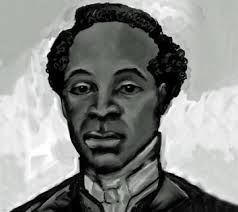|
Samuel Sharpe was born a slave in Montego Bay, Jamaica in 1780, and was owned by a white lawyer named Samuel Sharpe. He became a leader within the Burchell Baptist Church after being baptized. As a leader, Sharpe was allowed to preach to his fellow slaves but his message was about freedom from slavery. At the time labor laws did not exist and the slaves had not human rights protection; Sharpe was fought for the labor laws to be created for his people. The British Parliament held discussions about the abolition of slavery in 1831; the slave owners in Jamaica were ready to defend their property, which were their slaves. When Sharpe became aware of the refusal to abolish slavery he made his congregation aware of the news immediately. He began making plans to organizing his people to resist any unfavorable decision the slave owners made. Shape and his people were falsely informed that freedom was granted to his people, later they learned that the slave owners were refusing to free them. On December 31st, 1831, Sharpe organized a work stoppage amongst the slaves, they refused to cut the sugar cane which would ruin the crops and make the slave owners lose money. The House of Assembly passed laws that reduced the days the slaves would have off from work during the Christmas holidays, from three days to two days. In 1831 Christmas came on a Sunday and the slaves were expecting to be off the following Monday and Tuesday. The assembly was only willing to grant the slaves Christmas Day and the following day Boxing Day. Sharpe was adamant about his people being granted their days off and being paid for the days unless they would go on strike. The strike began and quickly spread to other areas of Jamaica that held slaves; the slaves were held on areas called parishes throughout the island of Jamaica. Sharpe started a peaceful strike against the slave owners who were against the liberation of his people, the strike grew into an aggressive confrontation between the slaves and the British on December 28th. A British militia confronted Sharpe and his people and this confrontation led to the burning of the Kensington Estate Great House; it also led to an eight day rebellion killing 186 slaves and 14 slavers. The rebellion was suppressed and over 500 slaves were captured and convicted of rebelling against the slave owners. Sharpe was labeled as the leader of the rebellion and was hanged for his actions in May of 1832 in Montego Bay. Sharpe’s owners were given $20 a slave as reparations for the number of slaves they lost in the rebellion. After Sharpe’s death he was initially buried in the Montego Bay Harbor and labeled as a criminal, later his remains were moved beneath the pulpit of the Burchill Baptist Church. Sharpe was eventually honored by his people when the Samuel Sharpe Teachers’ College Found was created, as well was the Samuel Sharpe square in Montego Bay; he is also displayed on the Jamaican $50 bill. Samuel Sharpe was a man who wanted a better life for his people and did what he could to free his people from the burden of slavery. He was intelligent enough to use his platform to educate and empower his people, so they would be willing to fight for their freedom. Mr. Samuel Sharpe, we proudly stand on your shoulders. J.A. Ward. References:
http://www.samsharpeproject.org/sam-sharpe http://jis.gov.jm/heroes/samuel-sharpe/ http://www.blackpast.org/gah/sharpe-samuel-ca-1780-1832 http://www.nlj.gov.jm/labourday/samsharpe.html
0 Comments
|
Details
Categories
All
Click Here to join our mailing list
|
Contact Us: |
Connect With Us |
Site powered by PIT Web Design


 RSS Feed
RSS Feed



